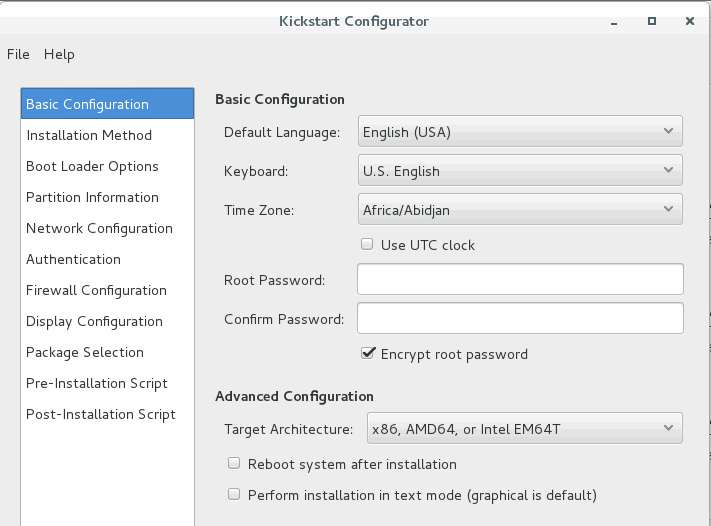Kickstart服务器
IP: 192.168.136.253 掩码:255.255.255.0 网关:192.168.136.2 DNS:192.168.136.2
- 安装部署HTTP服务器
# mkdir -p /content/pub/rhel7/x86_64/{isos,dvd}/
上传RedHat安装光盘镜像至 /content/pub/rhel7/x86_64/isos/rhel-server-7.2-x86_64-dvd.iso
安装HTTP服务器(Nginx)
# rpm -ivh http://nginx.org/packages/centos/7/noarch/RPMS/nginx-release-centos-7-0.el7.ngx.noarch.rpm # yum -y install nginx
修改默认网站配置文件
# vi /etc/nginx/conf.d/default.conf
server { listen 80; server_name localhost; root /content; index index.html index.htm; location ^~ /pub/ { autoindex on; autoindex_exact_size off; autoindex_localtime on; } error_page 500 502 503 504 /50x.html; location = /50x.html { root /usr/share/nginx/html; } }
启动Nginx服务并设置为开机启动
# systemctl start nginx
# systemctl enable nginx
修改网站目录SELinux类型
# chcon -t public_content_t -R /content/
设置开机自动挂载光盘镜像到/content/pub/rhel7/x86_64/dvd
# echo "/content/pub/rhel7/x86_64/isos/rhel-server-7.2-x86_64-dvd.iso /content/pub/rhel7/x86_64/dvd iso9660 loop,ro 0 0" >> /etc/fstab # mount -a
- 安装部署DHCP服务器
# yum -y install dhcp
修改配置文件
# vi /etc/dhcp/dhcpd.conf
log-facility local7; option domain-name "example.com"; option domain-name-servers 192.168.136.2; default-lease-time 600; max-lease-time 7200; subnet 192.168.136.0 netmask 255.255.255.0 { range 192.168.136.100 192.168.136.200; option routers 192.168.136.2; #路由器IP,可以写网关IP next-server 192.168.136.253; #TFTP Server 的IP地址 filename "pxelinux.0"; #pxelinux 启动文件位置 }
启动DHCP服务并设置为开机启动
# systemctl start dhcpd
# systemctl enable dhcpd
- 安装部署TFTP服务器
# yum -y install tftp-server
修改配置文件
# vi /etc/xinetd.d/tftp
# default: off # description: The tftp server serves files using the trivial file transfer # protocol. The tftp protocol is often used to boot diskless # workstations, download configuration files to network-aware printers, # and to start the installation process for some operating systems. service tftp { socket_type = dgram protocol = udp wait = yes user = root server = /usr/sbin/in.tftpd server_args = -s /var/lib/tftpboot disable = no #把这行改成no即可 per_source = 11 cps = 100 2 flags = IPv4 }
启动TFTP服务并设置为开机自启动
# systemctl start tftp
# systemctl enable tftp
将客户端所需启动文件复制到TFTP服务器
# yum -y install syslinux # cp /usr/share/syslinux/pxelinux.0 /var/lib/tftpboot/
复制启动镜像文件和启动配置文件至TFTP共享目录
# cp /content/pub/rhel7/x86_64/dvd/isolinux/{boot.msg,splash.png,vmlinuz,initrd.img} /var/lib/tftpboot/ # mkdir /var/lib/tftpboot/pxelinux.cfg/ # cp /content/pub/rhel7/x86_64/dvd/isolinux/isolinux.cfg /var/lib/tftpboot/pxelinux.cfg/default # chmod 644 /var/lib/tftpboot/pxelinux.cfg/default
修改启动配置文件
# vi /var/lib/tftpboot/pxelinux.cfg/default
default linux
timeout 600 ... label linux menu label ^Install Red Hat Enterprise Linux 7.2
kernel vmlinuz
append initrd=initrd.img ks=http://192.168.136.253/ks-config/ks7.cfg
...
- 创建Kickstart自动应答文件
# mkdir /content/ks-config/
# vi /content/ks-config/ks7.cfg
#platform=x86, AMD64, or Intel EM64T #version=DEVEL # Install OS instead of upgrade install # Keyboard layouts keyboard --vckeymap=us --xlayouts='us' # Root password rootpw --plaintext redhat
# System services services --enabled="chronyd"
# System timezone timezone Asia/Shanghai --isUtc # Use network installation
url --url="http://192.168.136.253/pub/rhel7/x86_64/dvd"
# System language lang en_US.UTF-8 # System authorization information auth --enableshadow --passalgo=sha512 # Use graphical install graphical # Network information network --bootproto=dhcp --device=eth0 # Reboot after installation reboot # System bootloader configuration bootloader --location=mbr # Partition clearing information clearpart --all --initlabel # Disk partitioning information part swap --fstype="swap" --size=2048 part /boot --fstype="xfs" --size=256 part / --fstype="xfs" --grow --size=1
%packages
@^minimal
@core
chrony
kexec-tools
%end
%post cat > /etc/yum.repos.d/rhel-dvd.repo << EOF [rhel-dvd] name=rhel dvd baseurl=http://192.168.136.253/pub/rhel7/x86_64/dvd gpgcheck=0 enabled=1 EOF %end
或者在有图形界面的RedHat上安装kickstart图形化配置软件system-config-kickstart
# yum -y install system-config-kickstart
运行system-config-kickstart
# system-config-kickstart

- 开通防火墙
# firewall-cmd --permanent --add-service={tftp,http}
# firewall-cmd --reload
- 启动客户端,安装部署系统
在所有客户端主机的BIOS中,将第一启动方式设置为PXE网络启动。设置完成后,重启所有客户端计算机即可完成大规模集中安装部署操作系统。